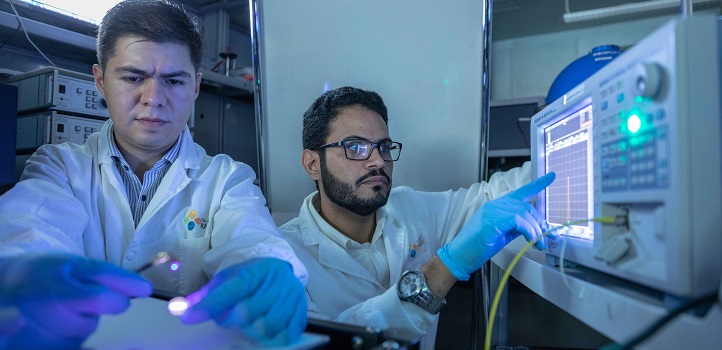Electrical Engineering
Brighter blue lights for faster communication
High-performance blue-light-emitting diodes could boost white-light, high-speed data transmission.

KAUST researchers have developed high-performance blue-light-emitting diodes useful for both solid-state lighting and visible light communication. © 2018 KAUST
Ultrabright diodes could bring white-light-mediated data transmission up to speed: KAUST researchers have developed high-performance, blue-light-emitting diodes useful for both solid-state lighting and visible-light communication. These superluminescent diodes (SLDs) could become primary light sources and make data communication available at the flick of a light switch, such as on the internet and in audio and video entertainment.
Light-emitting diodes have superior durability and ability to produce white light with minimal heat generation and energy loss compared to incandescent lightbulbs. They are becoming ubiquitous in everyday lighting applications ranging from general lighting to automotive headlamps and medical devices. They have also shown potential for wireless data transmission, but problems in achieving the required high-speed transmission rates have stalled implementation efforts and prompted researchers to turn to laser diodes. But, despite their higher efficiencies and data transmission rates, laser-based devices present the risk of eye injuries and a high speckle concentration, which are unwanted in solid-state lighting.
To address these shortcomings, a team led by Boon Ooi has now created SLDs on gallium-nitride semiconductor structures. “These diodes bring the advantages of light-emitting and laser diodes without showing any of their drawbacks,” explain Ph.D. students Abdullah Alatawi and Jorge Holguin-Lerma. The devices achieve exceptional light output power of 474 milliwatts and a data rate of 1.45 gigabits per second.
At the heart of the SLDs, the researchers used an indium-gallium-nitride semiconductor layer, which becomes optically active under applied electric voltage and generates light via a process combining spontaneous and stimulated emission. They sandwiched this layer between several positive and negative semiconductor layers. The active layer presents multiple quantum wells—potential wells narrowly split into numerous discrete energy levels, giving rise to the high number of states and, consequently, broad spectral emission of the diode when electrically produced electrons and holes recombine to create light.
When coupled with a commercially available luminescent plate, the blue SLD produces intense white light with a color rendering index of 85.1 and a correlated color temperature of 3392 Kelvin. This is consistent with its ability to accurately reproduce all colors present in natural white light and its suitability for solid-state lighting. “Altogether, these results prove the great potential of SLDs,” says Holguin-Lerma.
These blue SLDs could directly replace light emitters in current technologies, such as optical coherence tomography (a noninvasive imaging retinal test), picoprojection (tiny projectors) and sensing. The researchers are now developing SLDs displaying different emission colors and greater performance.
References
-
Alatawi, A.A., Holguin-Lerma, J.A., Kang, C.H., Shen, C., Subedi, R.C., Albadri, M.A., Alyamani, A.Y., Ng, T.K & Ooi, B.S. High-power blue superluminescent diode for high CRI lighting and high-speed visible light communication. Optics Express 26, 26355 (2018).| article
You might also like

Bioengineering
Smart patch detects allergies before symptoms strike

Computer Science
Green quantum computing takes to the skies

Electrical Engineering
Micro-LEDs boost random number generation

Bioengineering
Sensing stress to keep plants safe

Computer Science
Sweat-sniffing sensor could make workouts smarter

Electrical Engineering
New tech detects dehydration by touching a screen

Electrical Engineering
A new interface for efficient electronics

Electrical Engineering




